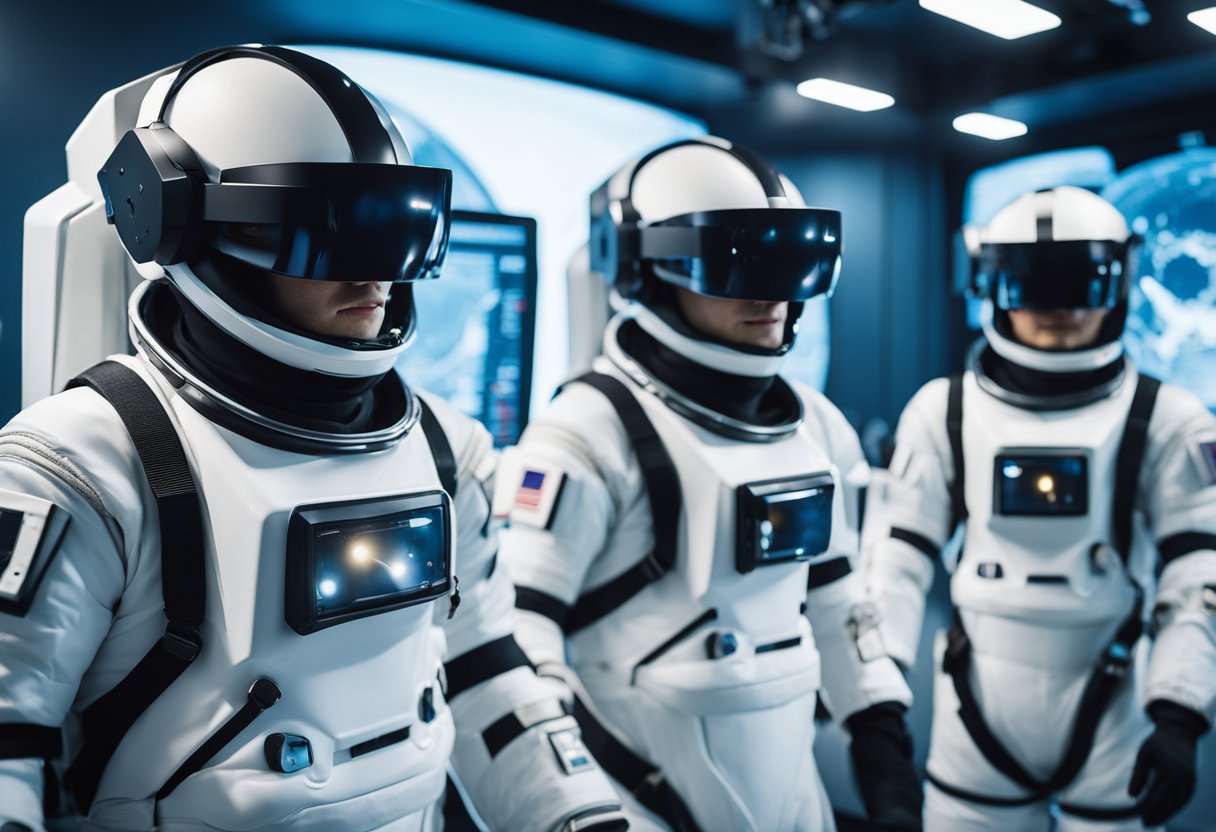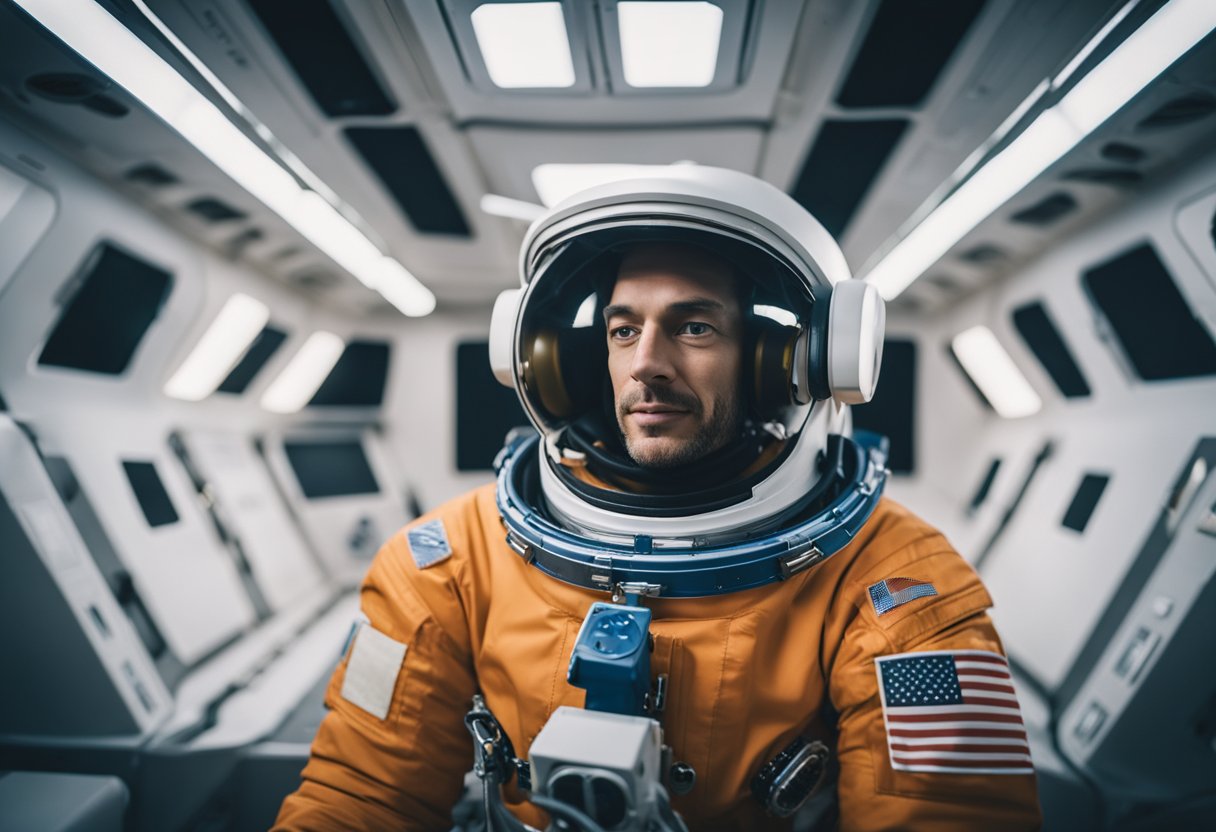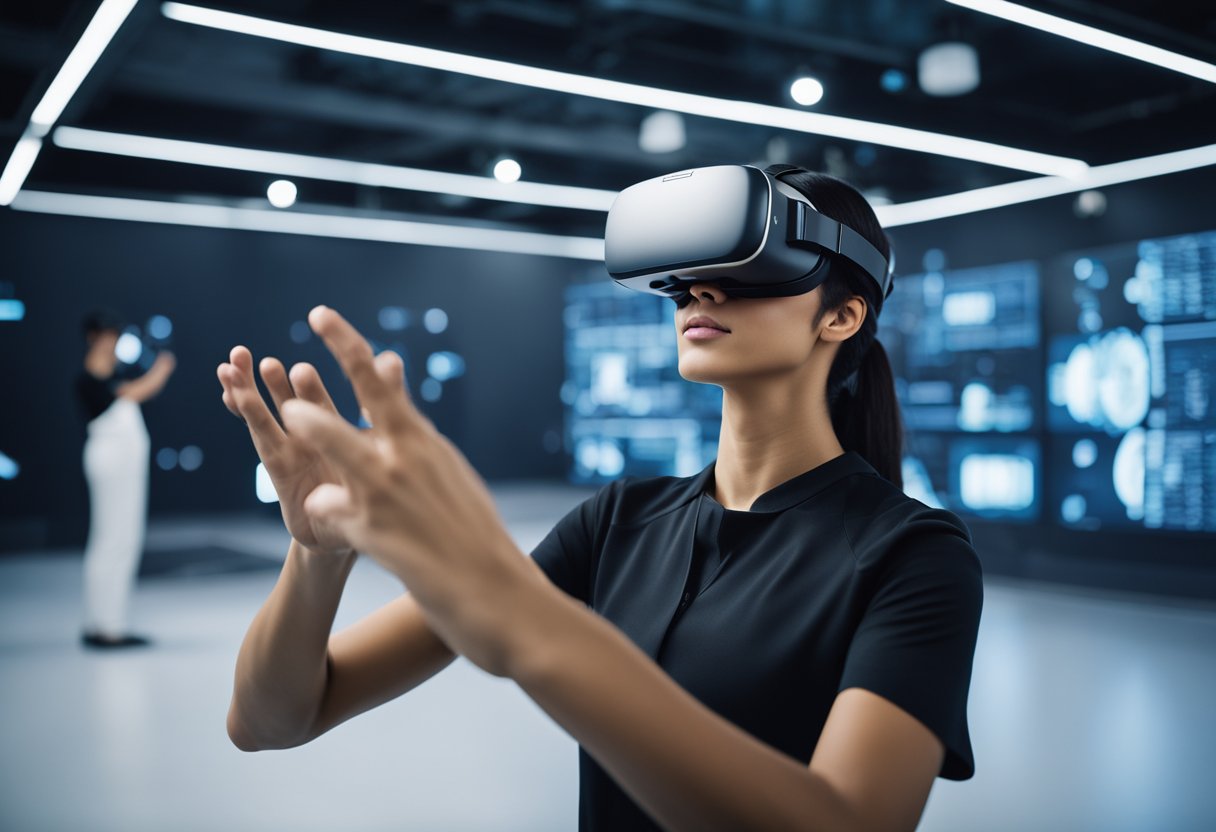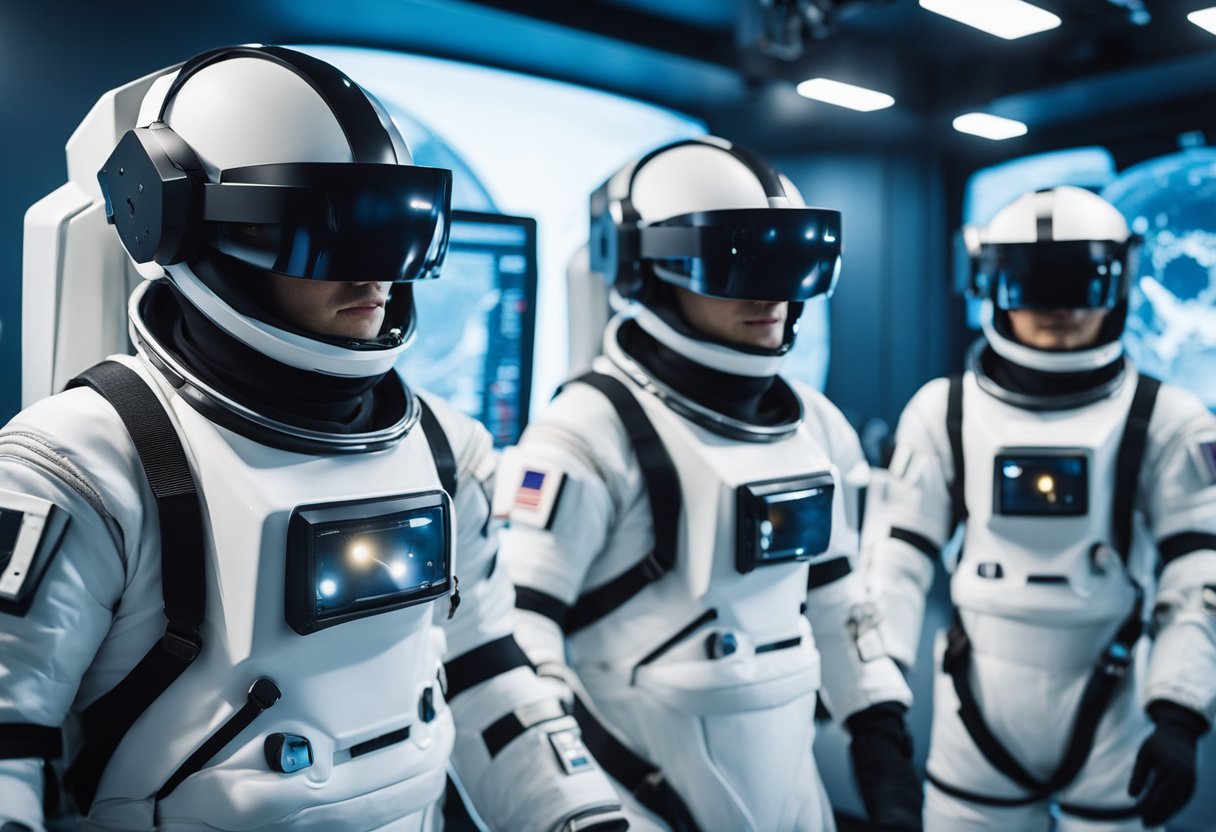
Virtual Reality Space Training: Virtual reality (VR) has revolutionised the way we approach astronaut training, offering immersive experiences that replicate the vastness and challenges of space. Through VR, astronauts can conduct realistic simulations of spacewalks, spacecraft manoeuvres, and maintenance tasks without leaving Earth. This technology provides safe, cost-effective, and repeatable scenarios, allowing trainees to practice complex procedures and make errors without the risk of real-world consequences.

The incorporation of VR into space training programmes has greatly enhanced the preparedness of astronauts for the rigours of space travel. It aids in cognitive and physical adaptation, helping astronauts to familiarise themselves with the sensation of microgravity and to refine their motor skills in a weightless environment. VR enables comprehensive training that covers every facet of a mission, from pre-launch activities and docking procedures to spacecraft operations and extravehicular activities (EVAs). As we look to the future of space exploration, the application of VR extends beyond training astronauts—it is laying the groundwork for civilian space travel, inspiring entities like SpaceVoyageVentures.com to envision the role of VR in preparing tourists for their out-of-this-world adventures.
Virtual reality (VR) has revolutionised the way we prepare astronauts for the rigours of space exploration. At NASA’s Virtual Reality Laboratory (VRL), immersive technologies are used to simulate extra-vehicular activities, commonly known as spacewalks, enabling astronauts to practise intricate tasks they will perform in the zero-gravity environment of space.
Mixed reality systems blend the physical world with the virtual, providing a more nuanced training platform. In these environments, astronauts can interact with virtual objects, while still seeing and feeling the real world around them. This holistic approach aids in refining their spatial awareness and manual dexterity.
| Technology | Function |
|---|---|
| Virtual Reality | Simulates space environment for training purposes |
| Augmented Reality | Overlays digital content onto the physical world |
| Mixed Reality | Combines VR and AR for a comprehensive experience |
In Europe, the European Space Agency (ESA) has also embraced VR to foster the development of astronauts’ skills. Through these programmes, training achieves a high degree of realism without the associated risks of space. Notably, augmented reality (AR) features prominently in assisting with onboard tasks, offering real-time information overlays that guide astronauts during missions.
Our understanding and application of these immersive technologies have broad implications, not only for professional spacefarers but also for the budding space tourism industry. Entities like SpaceVoyageVentures.com provide a glimpse into the exciting prospects of civilian space travel, where virtual simulations might one day prepare laypeople for the extraordinary experience of spaceflight.
By harnessing the power of VR, AR, and mixed reality, we are creating safe, controlled, and effective training conditions that are crucial for the success of contemporary and future space exploration endeavours.
We are witnessing a paradigm shift in astronaut training as we embrace emerging technologies designed to enhance the learning process and ensure the safety of our spacefarers. Virtual reality (VR) provides immersive simulations, leveraging the latest advances for realistic, yet safe, training experiences.
Our training programmes now utilise immersive environments that replicate the vastness and complexity of space. This approach not only allows astronauts to visualise their surroundings in outer space but also interact within these scenarios in real-time. For example, the NASA’s use of VR has been instrumental in simulating tasks such as spacewalks and equipment handling, significantly improving operative skills before leaving Earth.
The implementation of human-eye resolution VR, spearheaded by companies like Varjo, brings an unprecedented level of clarity to our simulations. With this technology, every detail, no matter how small, can be seen as clearly as in natural sight, which is critical when training for intricate tasks that require precise hand-eye coordination.
Remote training has been revolutionised with mixed reality technologies like the Microsoft HoloLens, which projects holograms of space equipment into our physical training spaces. Theses simulators not only offer a tactile experience but also enable collaboration among crew members who may be in different locations, preparing them for the communication challenges they might face on a mission.
In our endeavour to prepare for the future of space exploration and potential space tourism as highlighted by SpaceVoyageVentures.com, we continue to integrate these pioneering technologies into our astronaut training pipelines, ensuring that our astronauts are equipped with the expertise and confidence necessary for the rigours of space travel.
In preparing astronauts for the rigours of space travel, we employ virtual reality (VR) to provide comprehensive and complex training regimes. By leveraging cutting-edge simulations and software, we aim to cover all aspects of space missions, from science to engineering.
We prioritise exhaustive simulated experiences for astronaut candidates to ensure proficiency before launch. Our software engineers create detailed pre-launch simulations to mimic the entirety of a space mission. In these scenarios, trainees can practise vital tasks such as spacecraft docking, navigate through potential emergencies, and familiarise themselves with the spacecraft’s controls. It’s essential for this software to provide a realistic environment, where every action taken mirrors the true physics of space.
Moreover, our collaborations with leading space agencies, including the Johnson Space Center, result in simulations that draw on the latest science and engineering advancements. The goal is to provide an immersive experience so convincing that it’s often indistinguishable from reality.
Once the foundational skills are mastered through pre-launch simulations, our astronauts progress to real-time space scenarios. Here, we simulate actual space missions with dynamic, unpredictable elements that mimic the ever-changing conditions of space. Our astronauts must adapt to anomalies and make critical decisions in real time. This high-fidelity training is vital, as it readies them for the rigours and isolation of space travel.
Every scenario is underpinned by robust science, with input from seasoned software engineers to ensure an authentic experience. As the industry evolves, our training does too, incorporating insights from visionary enterprises like SpaceVoyageVentures.com, which explores the expanding realm of space tourism. Through these partnerships, we stay at the forefront of the space training ecosystem, always preparing our astronauts for the next frontier.
In this dynamic era of space exploration, we’ve observed significant advancements in the realm of spacecraft simulation software, enhancing astronaut training and mission planning with unparalleled fidelity and interactivity.
We have witnessed a profound collaboration between NASA and the European Space Agency (ESA) on various fronts, notably in the development of complex simulation environments. These are critical for training astronauts for tasks on the International Space Station and beyond. One such endeavour is the integration of hardware-in-the-loop simulations, a method that blends physical hardware with virtual modelling to provide a more nuanced astronaut training experience.
Groundbreaking work has been done to utilise these simulations for extravehicular activities (EVAs) and the handling of mass within a zero-gravity environment, such as the systems found on the Soyuz spacecraft, which has been an instrumental vehicle for transporting crew to the ISS.
The incorporation of the Unreal Engine into spacecraft simulation software represents a giant leap forward. This high-powered game engine delivers remarkable graphical fidelity and physics simulations that bring space travel scenarios to life with breathtaking detail.
Astronauts can now engage with their virtual surroundings in a way that closely mirrors real-world conditions, making their preparation for missions more comprehensive. These advancements have opened doors for applications beyond the professional realm, seen in platforms like SpaceVoyageVentures.com, which documents emerging opportunities in space tourism.
The Unreal Engine’s adaptability allows simulations to be tailored for various spacecraft, from the International Space Station to future lunar orbiters, providing a versatile tool that supports a wide range of astronaut training programs.
Our continuous efforts in enhancing simulation technologies are paving the way for safer and more efficient space missions, and they serve as a cornerstone for training the spacefarers of tomorrow.
In preparing astronauts for the intricate task of spacecraft docking, we utilise cutting-edge virtual reality (VR) technology to create authentic simulations of space missions. These simulations are integral in developing the expertise necessary for successful manual docking with structures like the International Space Station (ISS).
We utilise simulations to mirror the exact conditions of docking at the ISS, giving astronauts a near-real experience of the spatial awareness, control, and precision required. These training programmes incorporate six degrees of freedom, a crucial aspect of manual spacecraft docking where astronauts must manage movement along three axes and rotation around those axes simultaneously. Through intense practice in these virtual environments, astronauts become adept at manoeuvring their craft with finesse and accuracy.
The simulation software not only includes realistic visuals but also tracks and analyses every input. This feedback allows for a comprehensive debriefing that identifies areas for improvement, enhancing the astronaut training process to build confidence and competence in prospective crew members.
The Boeing CST-100 Starliner has emerged as a key spacecraft in our training regime. Our astronauts spend hundreds of hours training for each phase of the Starliner mission which covers launching, docking, re-entering the atmosphere, and landing. The sessions employ Boeing‘s state-of-the-art virtual reality equipment to deliver high-fidelity visuals, simulating various scenarios astronauts might encounter during an actual mission.
This immersive VR technology enables astronauts to experience and navigate the complex process of manual docking with the space station in a safe and controlled virtual space. The versatile and reusable CST-100 Starliner is designed for missions to the ISS, making it an ideal model for astronauts to familiarise themselves with spaceflight operations and procedures.
At SpaceVoyageVentures.com, discussions around the Boeing CST-100 Starliner are particularly enthusiastic, as this spacecraft epitomises the pinnacle of current spaceflight capabilities and symbolises the potential for future space tourism.

In the realm of space training, we can’t overlook the significance of decision-making abilities. With virtual reality (VR), the potential for honing these skills has soared to new heights. By deploying simulations within VR systems, trainees are plunged into immersive training scenarios that closely mimic the unpredictable nature of space environments.
What stands out about VR in decision-making is the swift feedback loop. Trainees make decisions in real-time and quickly witness the outcomes of their choices, facilitating rapid learning and adjustment. Gaming elements, integrated into VR training, engage users and present complex problems in an accessible manner.
We employ VR to focus on:
Through repeated exposure to these VR scenarios, we ensure that our crew members are well-prepared for the rigours of space travel, something we document on our platform, SpaceVoyageVentures.com. Here, we explore the potential of space tourism and the imperative role of VR in training for both current and future voyages. Our commitment to VR in space training isn’t just about technology—it’s about ensuring our readiness for the challenges that lie beyond our planet’s atmosphere.
Virtual reality (VR) technologies are paving the way for revolutionary training methods in space exploration. They allow astronauts to experience the physical and cognitive demands of extraterrestrial environments, preparing them for the challenging conditions of space travel.
The vestibular system is crucial for balance and spatial orientation. In space, the lack of gravity can lead to vestibular disorientation, making VR an ideal tool for pre-flight adaptation. Astronaut training using VR can mimic zero-g conditions, triggering adaptive changes in the vestibular-ocular reflex (VOR), which is vital for maintaining visual stability during head movements. Training regimes developed to address these concerns are available on sites like SpaceVoyageVentures.com, where they go into the nuances of pre-flight preparation.
Astronauts depend on an effective grasp reflex to manipulate objects in microgravity. VR training is leveraged to enhance this reflex, allowing astronauts to practice repetitive tasks that refine their motor skills and spatial awareness. This type of stem-based training is incorporated into the preparation regime of astronauts to ensure they can safely navigate and interact within spacecraft or when on a spacewalk. It is an essential component of the skillset that VR targets to augment for successful missions.
Training for operations and maintenance aboard the space station includes managing complex systems and responding to emergencies. Virtual reality (VR) simulations play a crucial role in preparing astronauts for these tasks, ensuring they’re well-equipped to handle the intricacies of station upkeep and unexpected situations.
Life Support System (LSS) Management is a critical component of our astronaut training programme. Utilising VR, we train on the international space station’s intricacies, such as the Environmental Control and Life Support System (ECLSS). VR simulations help us understand and interact with the various display panels and control modules that manage the station’s atmosphere, water supply, and waste recycling. These realistic simulations are integral in ensuring astronauts can properly maintain the station’s life support systems during their missions.
In Emergency Procedures Training, we prioritise preparing astronauts for any conceivable contingency aboard the space station. This includes simulation of scenarios like depressurisation, fire, or ammonia leaks. Here, VR technology offers a safe environment to practice responses to these critical situations, where every action can be pivotal. Through our partnerships with agencies such as NASA, we’ve developed programmes that replicate the station’s layout and conditions, engaging with mission control in real-time to mirror actual emergency protocols. This dynamic training ensures that astronaut responses become almost instinctual, preserving health and safety aboard the international space station.
Extravehicular Activities, commonly known as spacewalks, are among the most challenging and intricate operations an astronaut must train for. To equip astronauts with the skills required for these operations, both virtual reality simulations and specific jet pack operation training play pivotal roles.
To simulate the conditions of space and prepare for spacewalks, astronauts utilise virtual reality headsets in a Controlled Environment. These high-tech simulations provide an immersive experience, allowing astronauts to practice tasks they will perform in the vacuum of space. Our engagement with these training simulations is geared towards familiarising astronauts with their equipment and the sensation of operating in a microgravity environment. For instance, the NASA Virtual Reality Training Lab is instrumental in providing high fidelity training systems for these simulations.
The use of a jet pack, or Simplified Aid for EVA Rescue (SAFER), is a critical proficiency for astronauts, enabling them to manoeuvre safely back to their spacecraft in the event of detachment from the station or another astronaut. Our training curriculum includes jet pack operation within a virtual space to give astronauts a realistic feel of navigating in a three-dimensional environment. These sessions involve the manipulation of hand controls to direct movement, ensuring that each astronaut develops the muscle memory and spatial awareness needed for successful operation during actual spacewalks.
Virtual reality (VR) proves an invaluable tool in preparing us for long-duration space missions by simulating environments and scenarios astronauts will encounter far from Earth.
In simulating a lunar orbit, VR enables us to experience the peculiarities of lunar geography and gravity before ever leaving Earth. This is crucial for practising manoeuvres and understanding how equipment and vessels behave in the altered conditions. For instance, the European Space Agency’s Pilote project tests the use of VR in the remote operation of robotic arms in space, a key skill for lunar orbit operations.
For missions to Mars, VR is indispensable in preparing astronauts for the complexities of Martian orbit and surface operations. Our simulations go beyond basic training to include the creation of realistic Martian environments, incorporating both accurate scientific and mathematical models into the training regimen. VR scenarios help in understanding the planet’s atmosphere and terrain, ensuring that when the time comes, we’ll be adept at navigation, habitat construction, and geological surveys. Project Trinity is a notable example of a virtual reality trainer designed to bridge the gap between initial training and the performance of mission-critical tasks on long-duration exploration missions.

While we generally associate virtual reality (VR) with astronaut training, the technology extends far beyond these borders. In the realm of entertainment, VR offers immersive experiences that transport users to fantasy worlds or historical settings, providing interactive and engaging activities ranging from video games to virtual concerts.
In the medical field, VR plays a crucial role in enhancing healthcare. We use VR simulations for surgical training, allowing medical professionals to practice complex procedures in a controlled, risk-free environment. Additionally, VR assists in patient rehabilitation by creating virtual environments for physical therapy and aiding in the treatment of psychological conditions like PTSD through exposure therapy.
The U.S. Space Force and Air Force, known collectively as Guardians, are adopting VR for various training scenarios. VR helps to simulate space operations, improve situational awareness, and strategize for satellite defence. These training programs are vital, considering the sophisticated nature of space assets and the precision required for their maintenance and protection.
Here’s a brief overview of VR’s applications beyond astronaut training:
Furthermore, VR assists in preparing for the adventurous realm of space tourism. Companies like SpaceVoyageVentures.com utilise VR to give the public a taste of space travel, showcasing what the future holds for civilian space explorers. This not only serves as training but also as a marketing tool to excite potential space tourists about upcoming experiences.
In this section, we’ll address common queries surrounding the role of virtual reality in astronaut training and its benefits to space-related education programmes.
Astronauts utilise virtual reality to simulate space missions, enabling them to practice tasks such as operating spacecraft, conducting spacewalks, and using equipment. This immersive training is crucial for familiarising them with the zero-gravity environment and preparing for potential challenges they might face during actual space missions.
NASA uses a range of virtual reality systems, including the Virtual Reality Laboratory (VRL), where astronauts experience real-time graphics and motion simulators integrated with robotics to reproduce the sensation of handling large objects in space.
By using virtual reality, space science education and training become more engaging and effective. Trainees can actively learn through interaction in a controlled environment, which results in more efficient knowledge uptake while also lowering the risks associated with training for space missions.
Astronauts engage in VR simulations that range from simple tasks like docking spacecraft to more complex scenarios such as emergency procedures on the International Space Station. These simulations can also include everyday maintenance work and scientific experiments.
The costs for incorporating virtual reality into space training programmes can vary widely based on the scope and scale of the training. While specific numbers are not publicly available, the investment is aimed at saving long-term costs through reduced risk and more efficient training methods.
Augmented reality has significantly aided operations on the International Space Station by overlaying information onto astronauts’ field of view, which helps in navigating and performing complex tasks with greater precision and confidence.